Recent developments suggest that the implications of AI deployment are far-reaching. In May 2024, Google launched AI Overviews in the US as its latest advanced search feature.
Initially, Google made AI Overviews, formerly SGE, available in Search Labs as part of its experimental Search Generative Experience. Google has since rebranded the feature as AI Overviews.
As of May 2025, it has expanded to over 200 countries and 40 languages.
Google explained that the primary purpose of integrating AI Overviews into its search engine is to enhance user experience and improve user interaction with information.
Google developed AI overviews in response to changes in user behaviour and how they seek and consume information.
But what are AI Overviews? How do they work? How are they changing the rules of SEO? Can they enhance your content marketing strategy? And perhaps most importantly, is it even possible to be featured in them?
We will explore these and more, breaking down what AI Overviews mean for online visibility and how your business can adapt to the shift in Search.
What are AI Overviews?
AI Overviews are Google’s latest feature that displays direct AI-generated answers to users’ specific queries with the intention of providing useful and digestible information .
It is built on Google’s generative AI Gemini model, customised for Google Search, to fetch relevant content that aligns with the user’s search intent and is displayed in response at the very top of the Google SERPs, often before organic listings.
This summary aims to proffer direct answers to commonly asked users’ queries by pulling out insights from various reputable sources on the web while providing sources.
Key Stats
- 99% of AI overviews fall under 328 words, according to SurferSEO
- AI overview contains the exact user query 4% of the time
- According to Semrush’s study, in March 2025 alone, 4% of all queries triggered AI overviews.
- 2% of keywords that trigger AI overview are mostly informational
- 52% of sources contained in AI overviews rank in the top 10 search results for those keywords
- 12% of AI overviews contain an ordered list, while 61% contain an unordered list
- 3% of AI overviews contain an e-commerce source
- As of Dec 2024, 63% of health-related queries trigger AI overviews
- AI Overview appears together with a featured snippet on an average of 4% of the time
- Ahrefs reported that the presence of AI Overviews led to a 34.5% decline in click-through rates (CTR) for position 1 results based on an analysis of 300,000 keywords.
- 0.56% is the average position One CTR as of March 2024, but now has dropped to 0.031% as of March 2025
ChatGPT’s Disruption and Google’s Strategic AI Shift
ChatGPT is Google’s direct search competitor to their share capital rather than Yahoo and Bing. As of the first quarter of 2025, ChatGPT receives approximately 5.19 billion monthly visits.
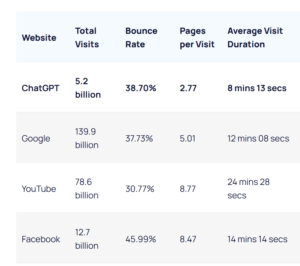
The popularity of ChatGPT among users early in its November 2022 release prompted Google to launch its own not-so-successful Bard four months later.
However, since the launch of Bard, Google has significantly improved its AI capabilities by introducing AI overviews. This new feature is unique because it improves Google’s responses to specific user queries.
Google claimed that AI overviews will make it easier to ask complex and new kinds of questions and get quick and straightforward AI-generated summaries with relevant cited sources. These AI-generated summaries appear at the top of Google SERPs, reflecting their importance in Google’s new approach to search.
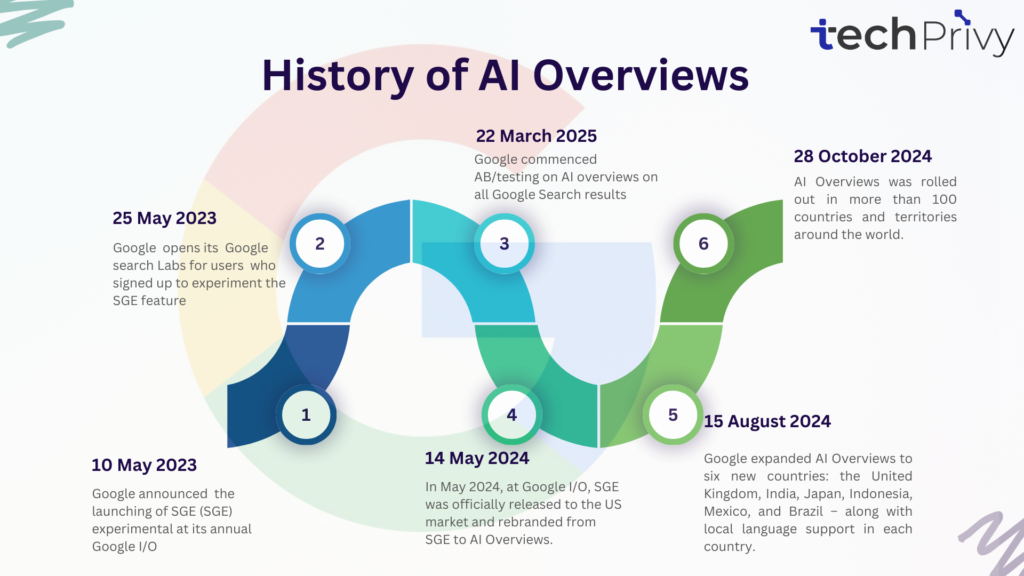
The rollout of the AI overview also reflected a change in Google’s Algorithm, thereby impacting SEO as we know it. According to Google VP Head of Search, Elizabeth Reid, this new feature is driving higher quality leads.
She said it helps users get quick and concise results for queries without having to click on multiple links. However, this new feature has created both a challenge and an opportunity.
What is the Google Gemini?
The Google Gemini is Google’s largest and most capable LLM model. It is the core that powers the multi-step reasoning generative capability of the new AI overview feature.
The model undergoes continuous training and retraining to comprehend the context of user queries, assess the reliability of sources, and convey this information in a comprehensible and user-friendly manner.
This model processes complex queries, interprets user intent, and pulls out relevant information from Google’s index and knowledge graph to create a human-like summary of results.
For example, when you search on Google for “Where can I learn Digital marketing?, it
automatically generates AI overviews of direct answers to the query by also
suggesting websites and platforms where you can learn digital marketing.
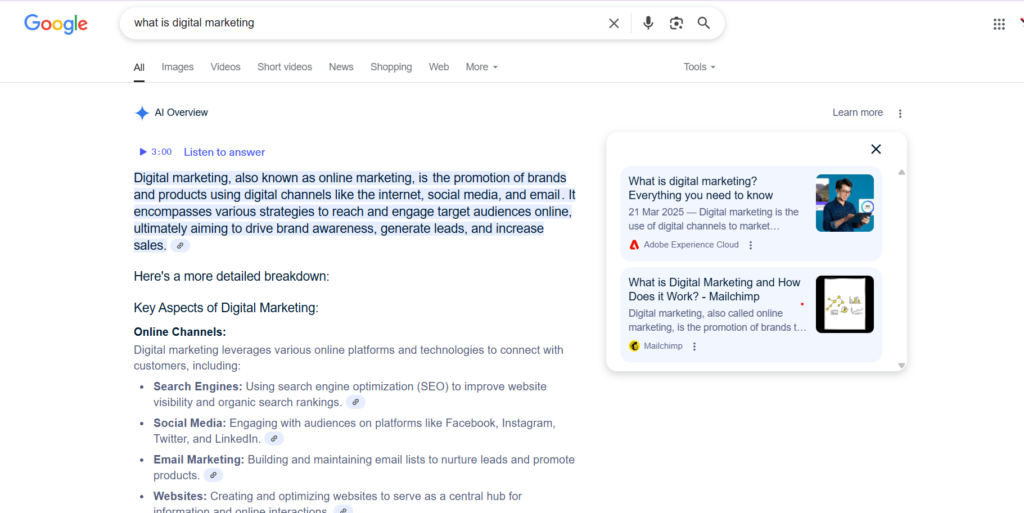
What’s the difference between AI Overviews and Featured Snippets?
Many people are likely to confuse AI Overviews with featured snippets. However, there are distinct differences between them. Featured Snippets are special search result boxes that appear at the top of Google’s search results. They are short texts called excerpts that are pulled directly from a webpage source and displayed at the top of Google SERPs, commonly known as position 0.
A featured snippet is between 40 and 50 words long and only contains a single link source that provides a quick, clear answer to user search queries. A featured snippet highlight can come in the form of a paragraph, list format, a video, bullet point instructions, images, or even tables.
However,
AI overviews don’t fetch or display content from a single source. Additionally, it is powered by AI, which aggregates content from multiple sources, synthesises that information, and displays answers along with several relevant links. It is particularly effective at displaying answers to complex or multi-part queries, indicating its dynamic nature.
Here is an example for both:

Source: Hubspot– Sample of a Featured Snippet In Position 0
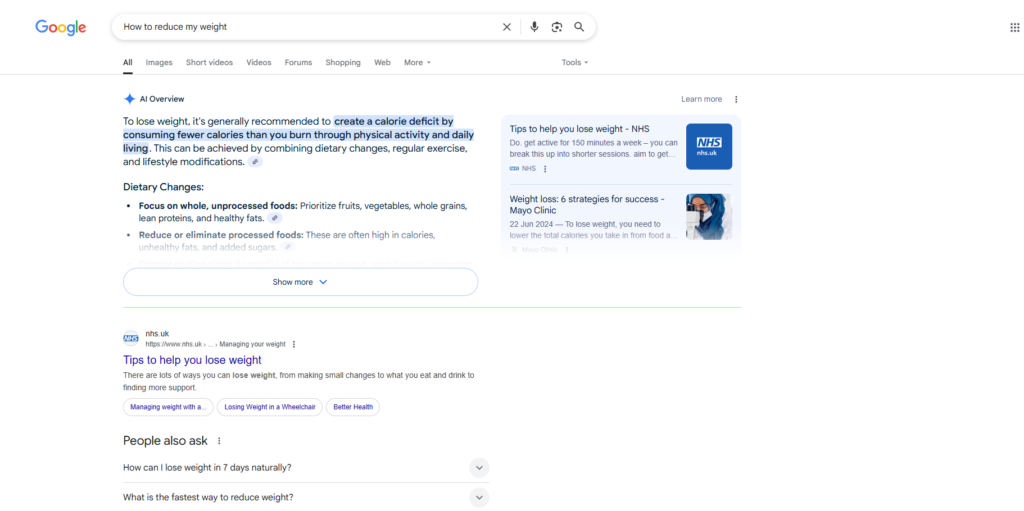
Image showing AI overviews for a user query
According to Semrush, 19% of SERPS for US mobile data have featured snippets. These summaries are AI-generated and displayed on the search results page. Occasionally, these AI-generated summaries push regular organic results down, resulting in decreased website traffic, diminished online visibility, and ultimately, decreased revenue.
Reports suggest that Google AI overviews and featured snippets could both appear in searches. In a survey conducted by Advanced Web Ranking that analysed 8000 keywords, featured snippets appear in 17.6% of cases and, on average, occur alongside AI overviews in 7.4% of instances.
How AI overviews work
The Google AI overview works differently from conventional search results. What I am trying to say is that Google’s system had previously simply indexed and ranked existing pages based on site authority, relevance, backlinks, and keyword optimisation.
Now, the Google-integrated Gemini AI synthesises content in real time and delivers direct answers generated by AI.
These answers appear when Google’s system determines that an AI summary will provide users with concise and helpful information for a specific query.
Consequently, Google’s system pushes traditional organic search results and ranked websites further down the page, resulting in reduced online visibility.
Google claims that AI overviews help:
- Drives over a 10% increase in usage
- Increase Higher-quality clicks for publishers
- Greater opportunity for content creators
- And more importantly, users are more satisfied.
Google’s AI Overviews workflow
According to the latest Semrush statistics, Google AI overviews now appear in over 13.14% of all US desktop searches as of March 2025, an increase from 6.49% in January. Although AI overviews are said to be triggered by informational keywords, the number is projected to rise as Google continues to push them across its value chain.
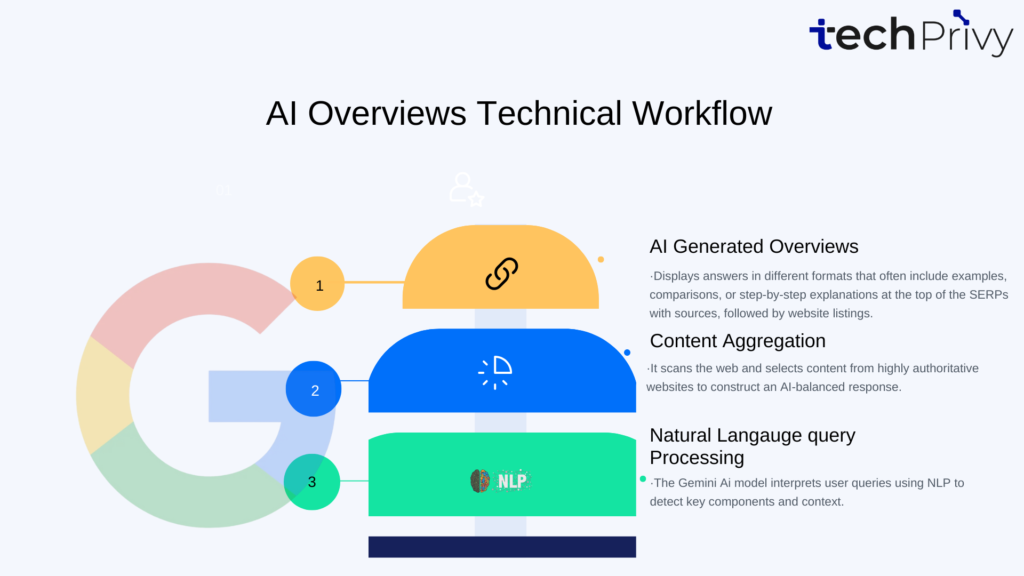
How Does Google Display AI Overviews in Search?
It is important to note that not all user queries trigger AI overviews. AI overviews appear mostly in informational long-tail keywords rather than transactional ones. Research by Seoclarity identified AI overviews appearing in just 1.2% of transactional queries and are absent from local queries. This means that information sites like blogs and news sites will be competing for visibility and clicks with AI Overviews.
This means that Google is not just a search engine but also an AI-powered answer engine.
I am saying this because, traditionally, Google functions as a search engine with the primary objective of helping users find relevant links across the web.
This significant shift positions Google as a tool for finding relevant information and a platform that identifies, interprets, and displays direct answers before users click on any link.
Google displays AI overviews in various forms and formats.
- Paragraph summaries that feel like human-written content
- Bullet points or list format for structured answers to queries
- Side-by-side comparison tables
- Multiple links to highly authoritative sources for more research
When Do AI Overviews Appear in Search Results?
As previously mentioned, Google does not trigger AI overviews for every user search query.
Currently, Google applies them selectively based on several factors:
- Multi-step or complex informational queries
- Queries that require a content summary from multiple sources
- Broad Topics or topics with evolving consensus
Currently, these topics do not appear in transactional, navigational, or commercial keyword searches; however, evidence suggests that Google will eventually expand them as AI overviews develop.
Sistrix conducted research to determine the number of domains appearing in the organic index, featured snippets, and AI overviews in the organic UK SERPs.
They found that:
- 18,404,705 different domains appear in the organic results of UK SERPs
- 491,606 different website links appear in the featured snippets
- 274,455 sources are currently cited and linked
This analysis could only suggest one thing:
Google is highly selective of the sources linked in its AI overviews.
Only high-ranking and authoritative sites are currently mentioned in the AI summary.
Analysis Suggests AI Overviews Prioritise Context to Keywords
According to research, Google displays AI overviews with the exact query keyword 5.4% of the time. This low percentage suggests that Gemini AI paraphrases information rather than returning exact long-tail keywords in the AI overview.
For example, when we search for the best month to visit the Canary Islands on Google. Here is the response:
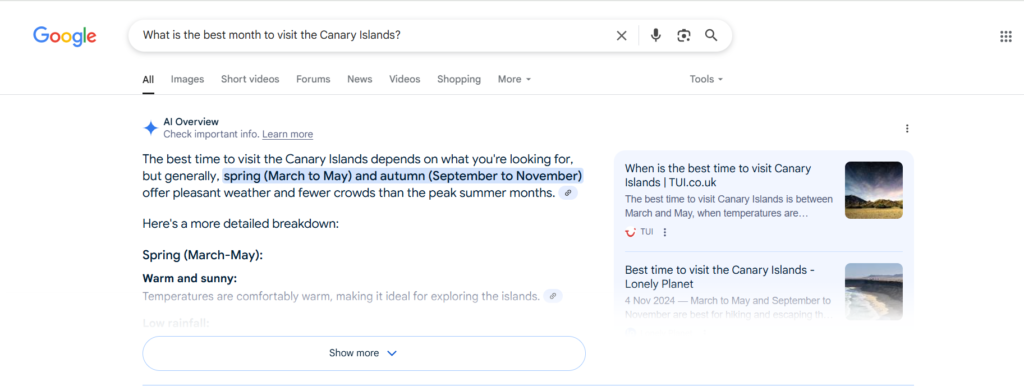
Looking at the image above, you will see that the keyword was ‘best month to visit the Canary Islands’, but AI Overviews uses the phrase ‘best time to visit the Canary Islands‘. This confirms that Google AI prioritises providing context, meaning, and relevance rather than keyword matching.
How Users Benefit from AI Overviews
Google has always prioritised its users’ experiences over everything else. It has also continuously encouraged publishers and content creators to write helpful, informative, and relevant content that readers will want to read.
With the AI overview implemented on the Google search engine, user experience and interaction have changed.
Google says AI Overviews will:
- Reduce users’ need to click on multiple website links to get direct answers
- Provide relevant and straightforward answers with the search result
- Provide options for additional reading through cited link
Is it possible to adjust AI Overviews?
For some user queries, users can adjust the complexity of the information provided by AI overviews. This option allows users to break down complex content into more straightforward or detailed content. However, Google has not yet rolled out this update. It is currently only available in the search lab for English queries in the United States.
What are the implications of AI Overviews on sponsored Google Ads?
It is clear AI Overviews has taken the top position 0 in Google SERPS for some queries. This means that paid and sponsored Ads are now pushed more than the SERPs, though still above organic listings.
The question is, where do paid and sponsored ads stand? Google clarified that sponsored ads will continue to occupy paid placements in the SERPS. They further said they would be clearly labelled to distinguish between organic and sponsored results.
It is important to note that Google are currently experimenting with Ads on AI Overviews.
Are paid ads shown in AI Overviews?
Yes, evidence shows that sponsored ads are showing up on AI Overviews.
While the percentage of sponsored ads in AI Overviews is currently low, this doesn’t diminish the fact that Google is reimagining sponsored ads.
At the Google Marketing Live event back in May 2024, Google introduced the idea of inserting ads into AI overviews.
However, Google clarified that they would ensure that the user experience remains uninterrupted.
Now, forward to Google Marketing Live 2025, held a few days ago, Google reinforces that stance. They want to help marketers and businesses make the most of the AI wave by reimagining the future of ads and shopping, and also help customers discover a product or service.
Here is an example of sponsored ads in AI overviews, which SEO Consultant Brodie Clark spotted and shared on his LinkedIn page.
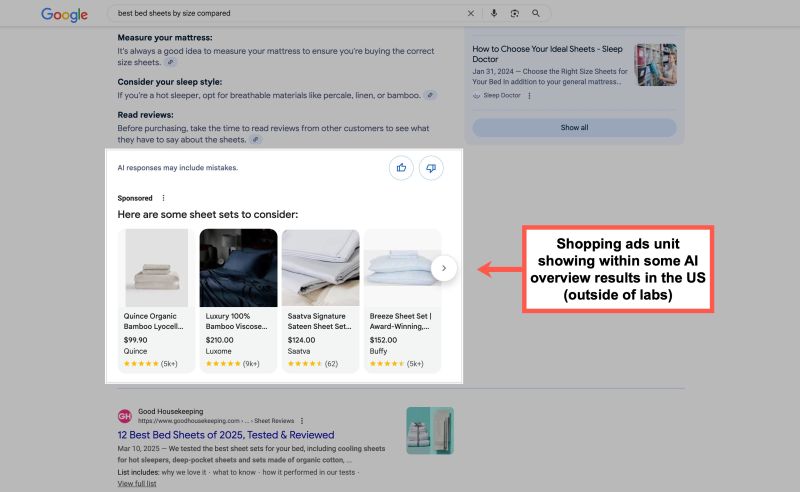
What does this mean for Search Marketers and Businesses?
Google’s algorithm has always rewarded websites that address real user needs rather than simply chasing rankings through keyword stuffing or low-quality content.
Google rewards these websites by placing them at the very top of search results. However, with the introduction of AI overviews and their appearance in the SERPs, the search landscape may undergo significant changes.
According to an analysis, the AI overview has potentially reduced traffic to traditional websites and is changing how brands capture online visibility.
This is more evident in a study conducted by Semrush, where analysis shows that 25% of desktop searches resulted in zero clicks.
Furthermore, the same research indicates that 17.3% of mobile searches resulted in zero clicks.
This might look insignificant; however, current analysis suggests that AI overviews could lead to more zero clicks.
Here is a Semrush analysis of zero-click searches from January 2025 to March 2025 for keywords that trigger AI overviews and those that do not.
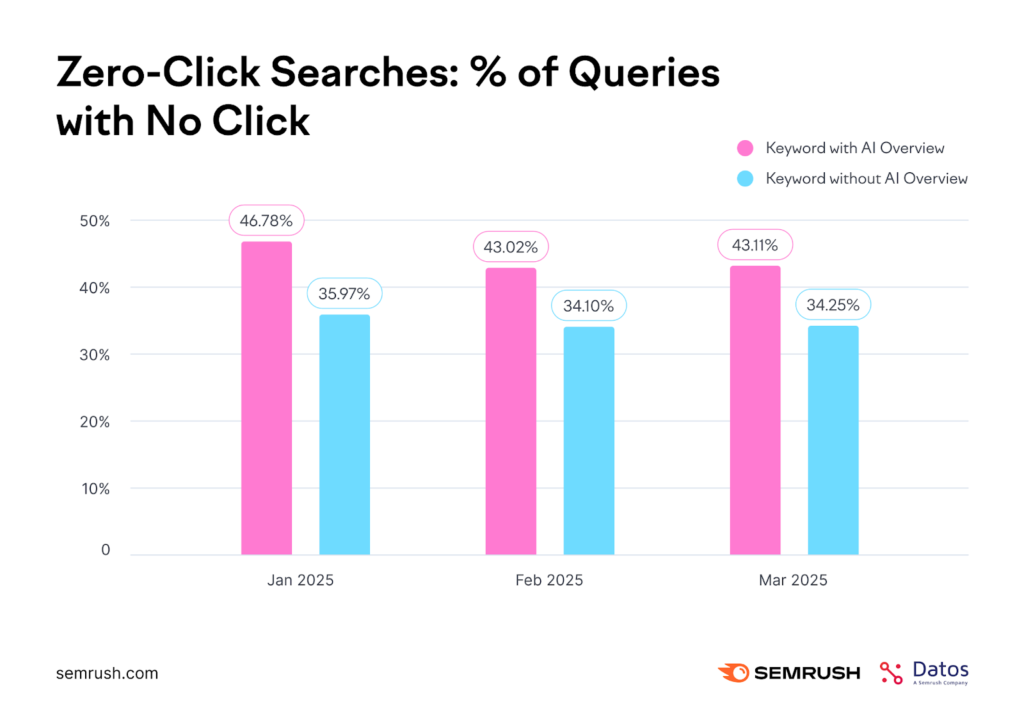
What are Zero-Click Searches
Zero-click search occurs when a user’s query returns a direct answer on the search engine result page (SERPs) without the user needing to click any further links. About 60% of Google search queries in the US and the EU region end in no clicks.
An example is when you search:
How old is Keir Starmer?.
You will get a response like this.
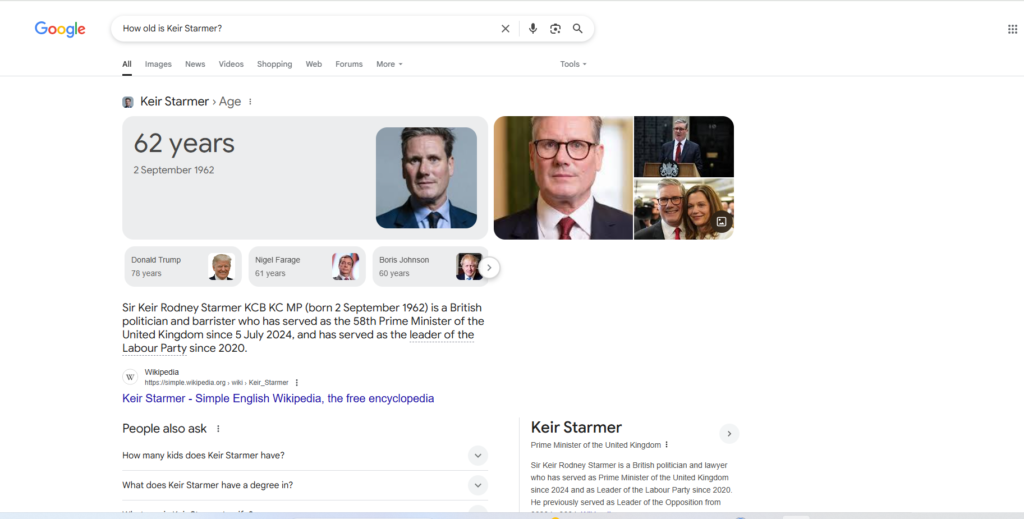
This is a direct response in which users do not need to click on a link to find out Keir Starmer’s age. Therefore, we refer to this type of query as a zero-click search.
Organisations’ Experiences: Drop in Click Through Rate
Mail Online, an arm of the Daily Mail, claimed in September 2024 that it experienced a 56% reduction in click-through rate on keywords it traditionally ranks for.
Mail Online attributed the reduction to the appearance of AI overviews in SERPs.
This resulted in MailOnline seeing a decline in click-through rate, even when they ranked first, experiencing a sharp decline on desktop CTR from 13% to below 5% and a drop from 20% to 7% on mobile CTR.
Google’s AI Overview Across Major Sectors
The inclusion of AI Overview across user queries has touched all sectors, from education to health, technology, finance, and entertainment. The health sector took a major chunk of the AI overview at 63%, followed by B2B tech with 32%.
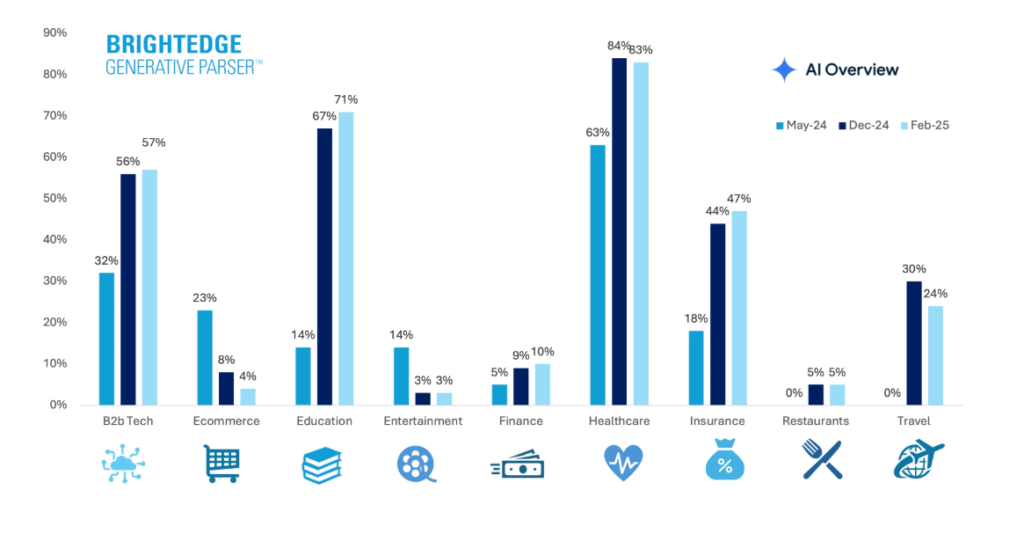
Source: BrightEdge
How to Align Your SEO Strategies for AI Overviews
Organisations and businesses plan to realign their SEO strategies. However, Google has not released any specific guidelines or procedures for optimising AI overviews.
Google claims that its system identifies which authoritative links or sources to feature in its AI overview.
This means publishers and content creators need not do anything special except continue to follow the standard SEO guidelines for appearing in searches.
SEO techniques will still be valid until Google releases a new update.
Currently, Google only includes high-authority links in its AI Overviews. However, if you optimise your content for the right terms and topics, Google will understand it and may cite you as a source in its AI Overviews.
Note: Research shows that 52% of sources contained in AI overviews rank in the top 10 searches for those keywords.
Below are key SEO best practices to take note of:
- Keep your web pages structured to be crawled and indexed by Google
- Target long-tail keywords
- Publish helpful and informative content
- Keep your site user-friendly to avoid an increased bounce rate.
- Apply on-page SEO for enhanced visibility.
- Build backlinks for high authority.
What to Expect from Google
Over the coming months and years, Google is expected to roll out more enhanced AI feature updates as it seeks to reinforce its authority in search. Below are some of the planned updates, as confirmed by Google.
- Adjustable summaries
- Inclusion of ads in AI overviews
- Planning Features
- Video-based queries
- AI improved shopping
Google claims the AI overview rollout is to help searchers find the best of what’s on the web.
What is the Long-term Solution for Businesses to Adapt to Changes in Google Algorithms?
Now that the rules of engagement have changed, how can businesses retain or enhance their online visibility and increase traffic? The simple answer is Branding, with a special focus on omnichannel.
Branding has never been this important. Although search is not going anywhere soon, it’s expanding its tentacles, and Google is definitely not being replaced but reimagined.
Conclusion
Generative AI has created a new battleground in SEO marketing where visibility is not just about getting ranks and clicks but about context, relevance, and delivering meaningful value in every interaction.


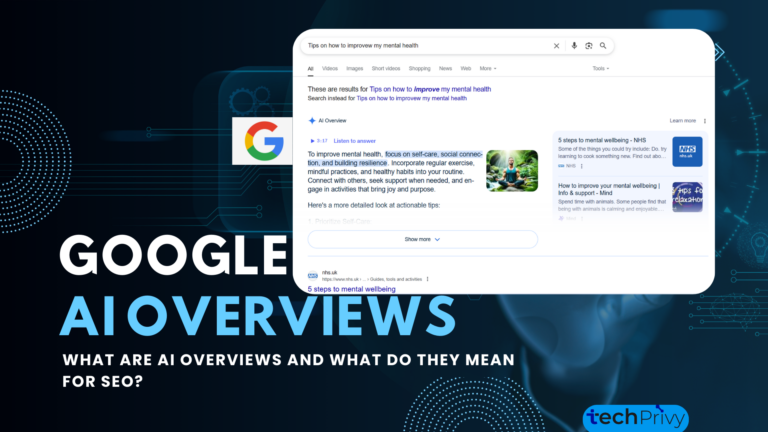

16 Comments
Your articles never fail to captivate me. Each one is a testament to your expertise and dedication to your craft. Thank you for sharing your wisdom with the world.
Hi my family member I want to say that this post is awesome nice written and come with approximately all significant infos I would like to peer extra posts like this
Your blog is a shining example of excellence in content creation. I’m continually impressed by the depth of your knowledge and the clarity of your writing. Thank you for all that you do.
Your writing is like a breath of fresh air in the often stale world of online content. Your unique perspective and engaging style set you apart from the crowd. Thank you for sharing your talents with us.
I do trust all the ideas youve presented in your post They are really convincing and will definitely work Nonetheless the posts are too short for newbies May just you please lengthen them a bit from next time Thank you for the post
I wanted to take a moment to commend you on the outstanding quality of your blog. Your dedication to excellence is evident in every aspect of your writing. Truly impressive!
you are in reality a good webmaster The website loading velocity is amazing It sort of feels that youre doing any distinctive trick Also The contents are masterwork you have done a fantastic job in this topic
Your blog is a breath of fresh air in the often stagnant world of online content. Your thoughtful analysis and insightful commentary never fail to leave a lasting impression. Thank you for sharing your wisdom with us.
I loved as much as you will receive carried out right here The sketch is attractive your authored material stylish nonetheless you command get got an impatience over that you wish be delivering the following unwell unquestionably come more formerly again since exactly the same nearly a lot often inside case you shield this hike
Your blog is a treasure trove of valuable insights and thought-provoking commentary. Your dedication to your craft is evident in every word you write. Keep up the fantastic work!
Your blog is a breath of fresh air in the often mundane world of online content. Your unique perspective and engaging writing style never fail to leave a lasting impression. Thank you for sharing your insights with us.
I just wanted to drop by and say how much I appreciate your blog. Your writing style is both engaging and informative, making it a pleasure to read. Looking forward to your future posts!
Wonderful beat I wish to apprentice while you amend your web site how could i subscribe for a blog web site The account aided me a acceptable deal I had been a little bit acquainted of this your broadcast provided bright clear idea
Your writing has a way of resonating with me on a deep level. I appreciate the honesty and authenticity you bring to every post. Thank you for sharing your journey with us.
Usually I do not read article on blogs however I would like to say that this writeup very compelled me to take a look at and do it Your writing style has been amazed me Thank you very nice article
Ive read several just right stuff here Certainly price bookmarking for revisiting I wonder how a lot effort you place to create this kind of great informative website